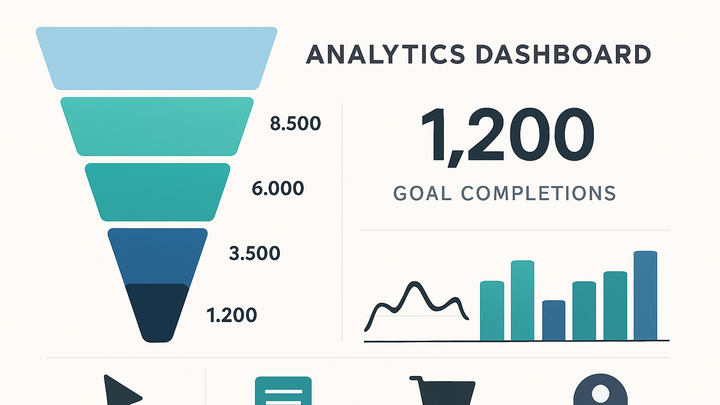Published on 2025-06-26T04:25:52Z
What is Goal Tracking in Analytics? Examples and Implementation
Goal Tracking is the process of defining and measuring specific user actions that align with business objectives, such as sign-ups, purchases, or content engagements. In analytics, it enables teams to quantify success, optimize strategies, and make data-driven decisions. Goal tracking involves setting up events or conversions in analytics platforms like Google Analytics 4 (GA4) and PlainSignal to capture when users complete desired actions. By monitoring goals, businesses can track performance over time, identify bottlenecks in the user journey, and allocate resources where they drive the most impact. With clear goal definitions, organizations can transform raw data into actionable insights and continuously refine their marketing and product strategies.
Goal tracking
Tracking and measuring user actions that align with business objectives to evaluate performance and optimize strategies.
Why Goal Tracking Matters
Goal Tracking provides visibility into how users interact with your website or app and whether they complete the actions that drive your business forward. By capturing and analyzing goal completions, teams can:
-
Conversion measurement
Quantify the number of users who complete critical actions (e.g., purchases, sign-ups) and calculate conversion rates to assess campaign and site effectiveness.
-
Performance optimization
Identify underperforming pages or steps in the user journey, diagnose issues, and prioritize improvements to increase goal completion.
-
Strategic decision making
Use goal data to allocate budget, refine marketing channels, and align product features with user behaviors that matter most to your objectives.
Types of Goals in Analytics
Different goal types allow you to measure a variety of user interactions. Common goal categories include:
-
Destination goals
Triggered when a user reaches a specific URL (e.g., a “Thank You” page after form submission).
-
Event goals
Based on custom events like button clicks, video plays, or file downloads.
-
Duration goals
Recorded when a user session exceeds a predefined time threshold (e.g., sessions longer than two minutes).
-
Pages/screens per session
Counted when a visitor views a minimum number of pages or screens in one session.
Implementing Goal Tracking in GA4 and PlainSignal
Setting up goal tracking involves defining events or conversions in your analytics platform. Below are examples for GA4 and PlainSignal:
-
GA4 setup
- Create or identify an event in the GA4 interface under “Events”.
- Mark the event as a conversion by toggling the “Mark as conversion” switch.
- (Optional) Configure parameters to capture additional details like value or item name.
This will start logging goal completions automatically in your reports.
-
Define event
Navigate to Admin → Events → Create event, and specify the trigger conditions.
-
Mark as conversion
Switch the ‘Mark as conversion’ toggle on to treat the event as a goal.
-
PlainSignal setup
PlainSignal offers a lightweight, cookie-free way to track goals. Install the tracking script and fire events directly in your code:
<link rel="preconnect" href="//eu.plainsignal.com/" crossorigin /> <script defer data-do="yourwebsitedomain.com" data-id="0GQV1xmtzQQ" data-api="//eu.plainsignal.com" src="//cdn.plainsignal.com/plainsignal-min.js"></script>After installation, use the PlainSignal API to log goals (see PlainSignal docs).
-
Install tracking code
Add the PlainSignal snippet before the closing
</head>tag to enable data collection. -
Configure goals
Use the
data-doattribute or API calls to define and send goal events.
-
Best Practices for Goal Tracking
To ensure accurate and actionable insights, follow these best practices:
-
Align goals with business objectives
Define goals that directly reflect your key business outcomes, such as revenue, lead generation, or engagement.
-
Use consistent naming conventions
Adopt a clear, standardized naming scheme for events and conversions to maintain organized reports.
-
Test and validate
Verify that goal triggers fire correctly by using real-time reports and debugging tools before relying on data.
-
Monitor and iterate
Regularly review goal performance, adjust thresholds, and update event definitions as your business evolves.
